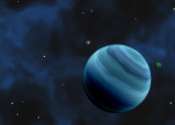Two studies cast doubt on existence of exomoon
Two teams working independently have looked at the possibility of an exomoon circling the exoplanet Kepler-1625b, which orbits the star Kepler-1625. They report little to no evidence supporting its existence. One team, led ...









